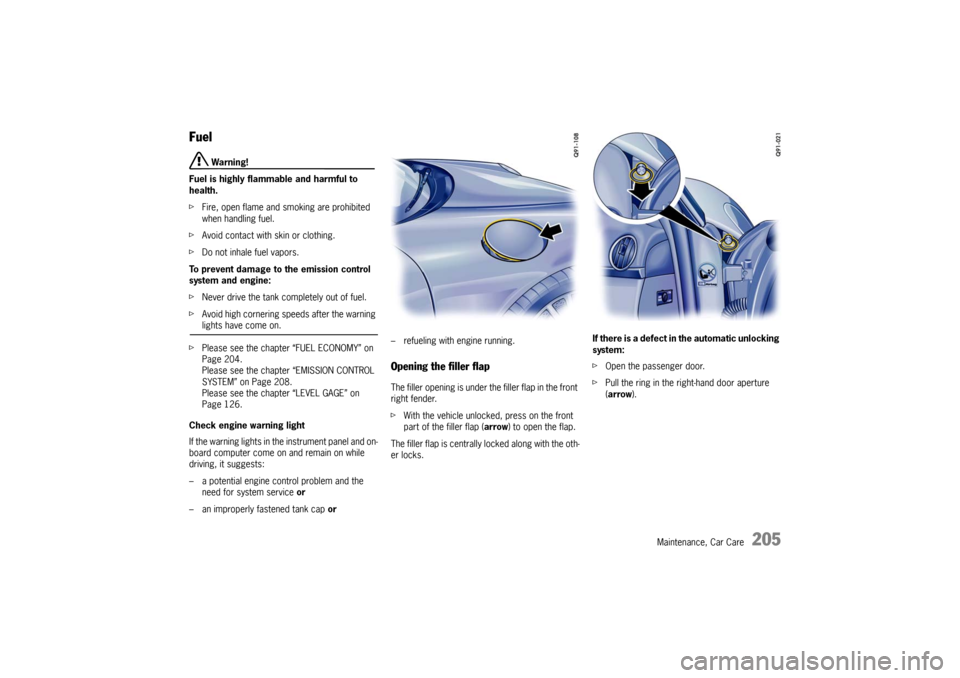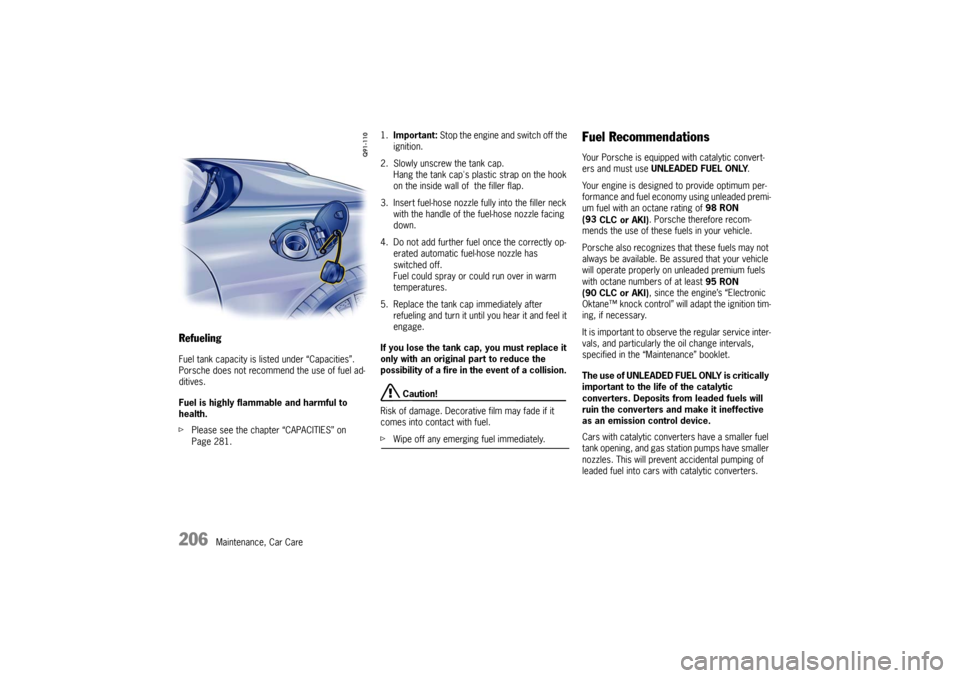2010 PORSCHE BOXSTER S fuel cap
[x] Cancel search: fuel capPage 9 of 294

Table of Contents
7
Trip Odometer ........................................... 121
Speedometer ................ ............................ 122
Changing over between Miles / Kilometers .. 122
Tachometer ............... ................................ 123
Turn Signal Indicator Light .......................... 123
High Beam Indicator Li ght ........................... 123
Gear Shift Indicator
(in vehicles with manual transmission) .......... 123
Cooling System ......... ................................ 124
Porsche Doppelkupplung (PDK) ................... 125
Fuel .......................... ................................ 126
Clock ............................ ............................ 127
Outside Temperature ................................. 127
Check Engine (Emission Control) ................. 129
On-Board Computer (B C) ............................ 130
Warnings on the instrument panel and the on-
board computer ............. ............................ 162Shifting Gears.................................. 171Manual Transmission, Cl utch ....................... 172
Drive-Off Assistant ..... ................................ 173
Porsche Doppelkupplung (PDK) ................... 174Mobile Roofs ................................... 181Convertible Top ......... ................................ 182
Windstop ................... ................................ 189
Hardtop ........................ ............................ 190Maintenance, Car Care .................... 195Exercise Extreme Caution when Working
on your Vehicle .......................................... 196
Coolant Level ............ ................................ 197
Engine Oil ................. ................................ 199 Engine Oil Level ..
......................................199
Engine Oil Recommendat ion ........................200
Brake Fluid Level ...... ..................................202
Fuel Economy .......... ..................................204
Operating your Porsche in other Countries ...204
Fuel Recommendation s ..............................206
Portable Fuel Containers ............................207
Fuel Evaporation Control ............................207
Emission Control Syst em ............................208
How Emission Control Works ......................209
Washer Fluid ............ ..................................210
Power Steering ........ ..................................211
Air Filter .................. ..................................211
Combination Filter .... ..................................211
Fluids/Oils for Manual Transmission
and Porsche Doppelkuppl ung (PDK) .............211
Wiper Blades .......... ..................................212
Car Care Instructions ................................213
Practical Tips, Emergency Service .... 221Exercise Extreme Caution when Working
on your Vehicle ............................ .............222
Tires/Wheels ............... ............................. 223
Loading Information ...................... .............234
Wheel Bolts ................................. .............236
Changing a wheel .......................... .............237
Flat Tire........................ ............................. 239
Lifting the Vehicle with a Lifting Platform
or Garage Lift ...... ......................................242
Spacers ...................... ..............................243
Electrical System ......................................245
Battery ................... ..................................249
Replacing the remote-control battery ..........254
Emergency Starting with Jumper Cables ......255 Bulb chart ..............
................................... 257
Lights, Replacing Bulb s ............................. 257
Headlights ............. ................................... 258
Number Plate Light . ................................... 266
Changing Light-Emitting Diodes and Long-Life
Bulbs ......................... .............................. 266
Adjusting Headlights .................................. 267
Towing ....................... .............................. 269
Vehicle Identification,
Technical Data ......... ....................... 273Vehicle Identification .................................. 274
Technical Data ....... ................................... 276
Tire Pressure for Cold Tires ....................... 277
Tires, Rims, Tracks .................................. 278
Driving Performance* ................. .............. 280
Capacities ............. ................................... 281
Weights ..................... .............................. 282
Dimensions ........... ................................... 282
Diagrams ................... .............................. 283
Page 10 of 294

8
Before driving off...
Dear Porsche Owner A lot has gone into the manufacture of your
Porsche, including advanced engineering, rigid
quality control and demanding inspections.
These engineering and safety features will be
enhanced by you... the safe driver... – who knows his/her car and all controls,
– who maintains the vehicle properly,
– who uses driving skills wisely and always drives within her/his own capabilities and the
level of familiarity with the vehicle.
You will find helpful hints in this manual on how to
perform most of the checks listed on the following
pages.
If in doubt, have these checks performed by your
authorized Porsche dealer.
Before driving off... Check the following items first f Turn the engine off before you attempt any
checks or repairs on the vehicle.
f Be sure the tires are inflated correctly.
Check tires for damage and tire wear.
f See that wheel bolts are properly tightened
and not loose or missing.
f Check engine oil level, add if necessary.
Make it a habit to have engine oil checked with
every fuel filling.
f Check all fluid levels such as windshield
washer and brake fluid levels.
f Be sure the vehicle battery is well charged and
cranks the engine properly.
f Check all doors and lids for proper operation
and latch them properly.
f Check, and if necessary replace worn or
cracked wiper blades.
f See that all windows are clear and unob-
structed.
f Check air intake slots and area between lug-
gage compartment lid and windshield. Ensure
that these areas are free of snow and ice, so
the heater and the windshield wipers work
properly. f
If a child will be riding in the vehicle, check
child seat/child seat restraint system to ensure
that restraints are properly adjusted.
f Child restraint systems will not fit into the
Sports bucket seat.
Do not install a child restraint system in the
Sports bucket seat.
The Sports bucket seat cannot be equipped
with the LATCH system and thus the airbag
system cannot be manually deactivated.
f Check all exterior and interior lights for opera-
tion and that the lenses are clean.
f Check the headlights for proper aim, and if
necessary, have them adjusted.
f Check under the vehicle for leaks.
f Be sure all luggage is stowed securely.
Emergency equipment It is good practice to carry emergency equipment
in your vehicle.
Some of the items you should have are:
window scraper, snow brush, container or bag of
sand or salt, emergency light, small shovel, first-
aid kit, etc.
Page 128 of 294

126
Instruments, On-Board Computer, Warnings
Level gage
When the ignition is on the fuel level is displayed.
f Please see the chapter “CAPACITIES” on
Page 281.
If the vehicle’s inclination changes (e.g. going up
or downhill), minor deviations in the indication may
occur. Note
If a small quantity of fuel
is added to a nearly emp-
ty fuel tank, the fuel ga ge cannot measure the add-
ed fuel accurately. The „remaining range“ readout
will also be incorrect.
Warning light “A” When the engine is running, the warning light
of the level gage lights up if less than approx.
2.6 U.S. gallons (10 liters) of fuel remains in the
tank.
Additionally, a warning is displayed in the on-board
computer.
f Fill up at the next opportunity.
Caution!
To prevent damage to the emission control
system and engine.
f Never drive the tank completely out of fuel.
f Avoid high cornering speeds after the warning lights have come on.
f Please see the chapter “EMISSION CONTROL
SYSTEM” on Page 208. If the level gage warning light flashes
, there
has been a system fault.
Additionally, a warning is displayed in the on-board
computer.
There will then be no reserve warning.
f To remedy the fault, go to an authorized
Porsche dealer.
Fuel
Page 131 of 294

Instruments, On-Board Computer, Warnings
129
Check Engine
(Emission Control)The emission control system detects malfunctions
early that could, for example, cause increased
pollutant emissions or consequential damage.
Faults are indicated by a continuously lit or
flashing instrument panel warning light.
The faults are recorded in the control unit's fault
memory.
The warning light in the instrument panel lights up
when the ignition is switched on as a bulb check
and goes out approx. 4 seconds after the engine
starts. If the warning light does not light up, have
the bulb replaced promptly.
The warning light in the instrument panel flashes to
indicate operating states (e.g. engine misfiring)
which might cause damage to certain parts of the
emission control system.
fIn this case, immediately reduce the engine
load by easing off the accelerator.
f In order to avoid consequential damage to the
engine or emission control system (e.g. cata-
lytic converter), have the fault diagnosed and
rectified immediately at the nearest authorized
Porsche dealer. If the warning light in the
instrument panel lights up
permanently without flashing before and remains
on while driving, it suggests:
– a potential engine control problem and the need for system service or
– an improperly fastened tank cap or
– the vehicle was refueled while the engine was running.
f Stop immediately at a suitable and secure
place and check tank cap for proper fastening.
If tank cap was fastened correctly, see your au-
thorized Porsche dealer for service as soon as
possible.
Caution!
If the check engine warning light in the in-
strument panel is flashing, serious catalytic
converter damage and power loss will soon
occur.
Prolonged driving with the check engine war-
ning light on could cause damage to the
emission control system. It also could affect
fuel economy and driveability.
f Have the fault remedied at the nearest authorized Porsche dealer immediately.
Warning Light
Page 166 of 294

164
Warnings
LIMIT
30Selected speed limit (e.g. 30 mph) for the
acoustic warning signal has been exceeded.
Adjust your speed if necessary.
Fuel gage warning
light Consider remaining range Refuel at next opportunity.
Check engine oil level Start engi
ne oil level measurement in the
on-board computer.
Engine oil pressure too low Stop immediately at a suitable place, measure oil level with the on-board computer and, if nec-
essary, add engine oil.
Warning light
Temperature gage Engine temperature too high Switch
engine off and let it cool.
Check coolant level and, if necessary,
add coolant.
Temperature gage
warning light flash-
es Check coolant level Switch en
gine off and let it cool.
Check coolant level and, if necessary, add cool-
ant.
Engine diagnostics – workshop Stop imme diately at a suitale place and check
tank cap for proper fastening. If the tank cap
was fastened correctly, consult your authorized
Porsche dealer.
Reduced engine power Consult yo ur authorized Porsche dealer.
Temperature gage
warning light flash-
es Failure of
engine compartment blower
Consult your authorized Porsche dealer.
Warning Battery/generator Stop at a safe place and switch the engine off.
Do not continue driving.
Have the fault remedied at an authorized
Porsche dealer.
Instrument
panel On-board
computerText display on on-board
computer Meaning/measure
Page 207 of 294

Maintenance, Car Care
205
Fuel
Warning!
Fuel is highly flammable and harmful to
health.
f Fire, open flame and smoking are prohibited
when handling fuel.
f Avoid contact with skin or clothing.
f Do not inhale fuel vapors.
To prevent damage to the emission control
system and engine:
f Never drive the tank completely out of fuel.
f Avoid high cornering speeds after the warning lights have come on.
f Please see the chapter “FUEL ECONOMY” on
Page 204.
Please see the chapter “EMISSION CONTROL
SYSTEM” on Page 208.
Please see the chapter “LEVEL GAGE” on
Page 126.
Check engine warning light
If the warning lights in the instrument panel and on-
board computer come on and remain on while
driving, it suggests:
– a potential engine control problem and the need for system service or
– an improperly fastened tank cap or – refueling with engine running.
Opening the filler flapThe filler opening is under th
e filler flap in the front
right fender.
f With the vehicle unlocked, press on the front
part of the filler flap ( arrow) to open the flap.
The filler flap is centrally locked along with the oth-
er locks. If there is a defect in
the automatic unlocking
system:
f Open the passenger door.
f Pull the ring in the right-hand door aperture
(arrow ).
Page 208 of 294

206
Maintenance, Car Care
Refueling Fuel tank capacity is listed under “Capacities”.
Porsche does not recommend the use of fuel ad-
ditives.
Fuel is highly flammable and harmful to
health.
fPlease see the chapter “CAPACITIES” on
Page 281. 1.
Important: Stop the engine and switch off the
ignition.
2. Slowly unscrew the tank cap. Hang the tank cap's plastic strap on the hook
on the inside wall of the filler flap.
3. Insert fuel-hose nozzle fully into the filler neck
with the handle of the fuel-hose nozzle facing
down.
4. Do not add further fuel once the correctly op- erated automatic fuel-hose nozzle has
switched off.
Fuel could spray or could run over in warm
temperatures.
5. Replace the tank ca p immediately after
refueling and turn it until you hear it and feel it
engage.
If you lose the tank cap, you must replace it
only with an original part to reduce the
possibility of a fire in the event of a collision.
Caution!
Risk of damage. Decorative film may fade if it
comes into contact with fuel.
f Wipe off any emerging fuel immediately.
Fuel Recommendations Your Porsche is equipped with catalytic convert-
ers and must use UNLEADED FUEL ONLY .
Your engine is designed to provide optimum per-
formance and fuel economy using unleaded premi-
um fuel with an octane rating of 98 RON
(93 CLC or AKI) . Porsche therefore recom-
mends the use of these fuels in your vehicle.
Porsche also recognizes that these fuels may not
always be available. Be assured that your vehicle
will operate properly on unleaded premium fuels
with octane numbers of at least 95 RON
(90 CLC or AKI) , since the engine’s “Electronic
Oktane™ knock control” will adapt the ignition tim-
ing, if necessary.
It is important to observe the regular service inter-
vals, and particularly the oil change intervals,
specified in the “Maintenance” booklet.
The use of UNLEADED FUEL ONLY is critically
important to the life of the catalytic
converters. Deposits from leaded fuels will
ruin the converters and make it ineffective
as an emission control device.
Cars with catalytic converters have a smaller fuel
tank opening, and gas station pumps have smaller
nozzles. This will prevent accidental pumping of
leaded fuel into cars with catalytic converters.
Page 209 of 294

Maintenance, Car Care
207
Unleaded fuels may not be available outside the
continental U.S. and Canada. Therefore, we rec-
ommend you do not take your car to areas or
countries where unleaded fuel may not be availa-
ble. Octane ratings Octane rating indicates a fuel’s ability to resist det-
onation. Therefore, buying the correct octane gas
is important to prevent engine “damage”.
The RON octane rating is based on the research
method. The CLC (U.S. Cost of Living Council oc-
tane rating) or AKI ( anti knock index) octane rating
usually displayed on U.S. fuel pumps is calculated
as research octane numb er plus motor octane
number, divided by 2, that is written as:
The CLC or AKI octane rating is usually lower than
the RON rating:
For example: 95 RON equals 90 CLC or AKI
Fuels containing ethanolDo not use any fuels containing more than 10 per-
cent ethanol by volume.
We recommend, however, to change to a different
fuel or station if any of the following problems oc-
cur with your vehicle:
– Deterioration of driveability and performance.
– Substantially reduced fuel economy.
– Vapor lock and non-start problems, especially at high altitude or at high temperature.
– Engine malfunction or stalling. Portable Fuel Containers
Danger!
Portable fuel containers, full or partially
empty, may leak causing an explosion, or re-
sult in fire in case of an accident.
f Never carry additional fuel in portable contain-ers in your vehicle.
Fuel Evaporation Control Fuel tank venting The evaporation chamber and the carbon canister
prevent fuel from escaping to the atmosphere at
extreme high outside temperatures, when driving
abruptly around curves and when the car is parked
at an incline or in any other nonlevel position. Vapor control system and storage When the fuel tank is filled, vapors are collected in
the evaporation chamber by a vent line leading the
vapors to the carbon canister where they are
stored as long as the engine does not run. Purge system When the engine is running, the fuel vapors from
the canister will be mixed with fresh air from the
ambient air of the canister. This mixture will be
directed to the intake air housing by the tank vent
line, mixed with the intake air and burned during
normal combustion.
RON+MON
2
R+M
2
or